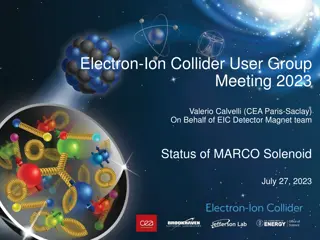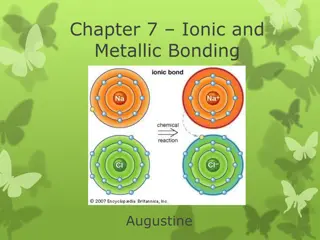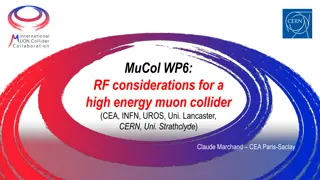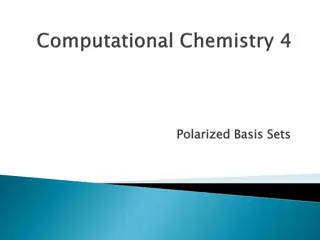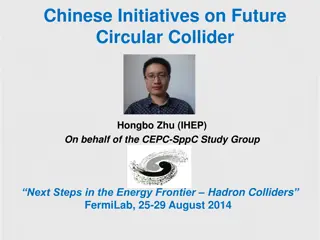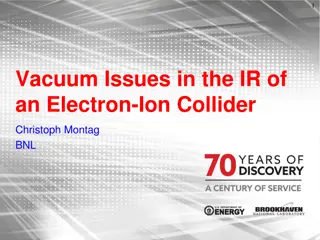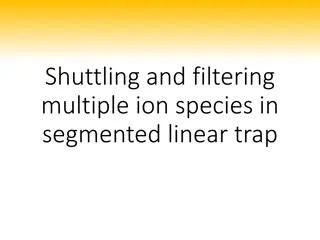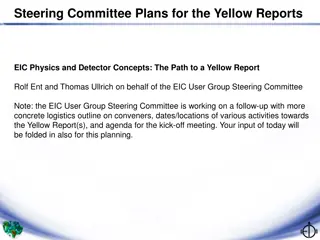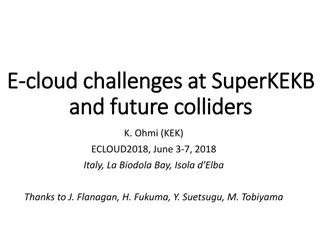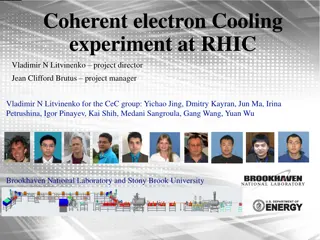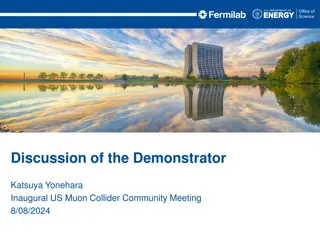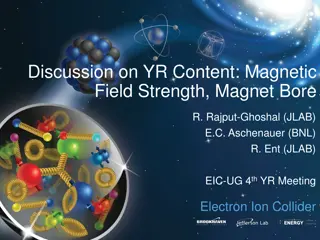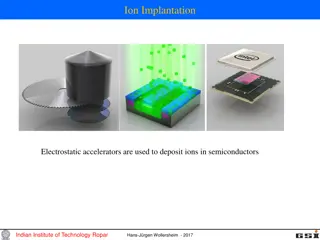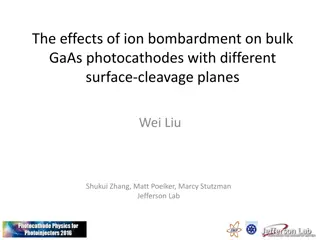Challenges and Considerations in Electron-Ion Collider Detector Development
Exploring the development of detector systems for Electron-Ion Colliders (EIC) involves addressing various issues such as detector acceptance for low Q2 and high Q2, unique beam characteristics, and the need for specialized components like bend magnets and polarimeters. Key considerations include polarized beams, particle identification, tracking, and managing beam backgrounds. The EIC's design requires innovative solutions to optimize detector performance and achieve precise measurements of particle interactions.
Download Presentation

Please find below an Image/Link to download the presentation.
The content on the website is provided AS IS for your information and personal use only. It may not be sold, licensed, or shared on other websites without obtaining consent from the author.If you encounter any issues during the download, it is possible that the publisher has removed the file from their server.
You are allowed to download the files provided on this website for personal or commercial use, subject to the condition that they are used lawfully. All files are the property of their respective owners.
The content on the website is provided AS IS for your information and personal use only. It may not be sold, licensed, or shared on other websites without obtaining consent from the author.
E N D
Presentation Transcript
Machine Detector Interface Machine Detector Interface at the Electron at the Electron- -Ion Collider Ion Collider Mike Sullivan EICUG 2019 July 22-26 Paris, France 1
Outline Outline Introduction Detector Issues Machine Issues Unique features of the EIC Some general questions for the detector and accelerator teams Conclusion and Discussion 2
Introduction Introduction Some previous EICs The first electron-ion fixed target collider was SLAC (up to 360 Hz single pass beam) HERA was the first e-P collider to use storage rings for both particles The modern EIC is a new accelerator complex Both stored beams have high currents and many bunches compared to previous electron-ion colliders The beam energies are on the low side of modern machines The electron energies are very similar to the B-factories with the exception of the LHeC which has an electron energy closer to LEP (60 GeV) Proton beam energies are 60-250 GeV again, except for the LHeC which has 7 TeV 3
Detector Issues Detector Issues Detector acceptance down to very low Q2, very low x Also high Q2 and low x Very low angle detectors, taggers Even down to zero degrees This means that detectors are very close to the beam envelope This also means bend magnets are needed soon after collision in order to separate the beam particles from the very small angle final state particles that are still in the beam envelope after collision The small angle detectors need a thin (or no) window in the beam pipe wall 4
More detector issues More detector issues Polarized beams The spin physics of the proton needs this requirement Both beams (~75%) Polarimeters (need to measure the polarization) General 4 detector 2 T solenoidal magnetic field Calorimetry Particle ID Tracking Vertexing (small, thin radius central beam pipe) 5
Still more detector issues Still more detector issues e- / e+ gas molecule Coulomb Beam Backgrounds Electron beam Coulomb (elastic scattering) Beam-gas (inelastic scattering) Touschek (inter-bunch scattering) Luminosity Beam tails (mostly electron beam?) The beam tail is generated by the above interactions as well as by beam-beam effects Non-gaussian beam tails can be quite large in the electron beam The electron beam has very high damping terms from SR Collimation is necessary and crucial in order to control the above backgrounds and the SR background from the beam tail e- / e+ gas molecule BGB 6
More on detector backgrounds More on detector backgrounds Beam pipe scrubbing The SR from the electron beam digs out the gas molecules imbedded in the beam pipe metal This generates gas pressure around the ring dynamic gas pressure which can be 10-100 times higher than the zero-current pressure Synchrotron Radiation is a major background from the electron beam Direct hits on the central beam pipe is the first concern If these hits are usually coming from beam particles in the high sigma region where there is great uncertainty as to what the actual hit rate will end up being (Beam-tail profile) The direct hit rate generally sets the radius of the central beam pipe The electron high beam current forces us to worry about secondary scattering Forward as well as backward one bounce scattering In some cases tertiary (2 bounce photons) can be an issue if the source has a very high incident photon rate Usually these rates are not very high and can be ignored but too many hits from a single crossing can swamp a detector by making too much occupancy 7
Accelerator Issues Accelerator Issues High beam currents 1-2.5 A for eRHIC 1-3 A for JLEIC Short beam bunches ~1 cm for JLEIC ~2 cm electrons and ~6 cm protons for eRHIC Various beam energies 20-200 GeV protons and 3-12 GeV electrons (JLEIC) 40-275 GeV protons and 5-18 GeV electrons (eRHIC) Polarization 8
More accelerator issues More accelerator issues Luminosity Low y* The accelerator team may discover they can go to lower y* values. Then the y max is larger in the FF quads making more SR at larger distances from the beam axis in the FF quads. Continuous injection Low backgrounds Beam stability Bunch-by-bunch feedbacks Transverse Longitudinal Low level RF (electron beam) 9
EIC, High Beam Currents & Several Energies EIC, High Beam Currents & Several Energies The EIC is a unique concept for both the accelerator and the detector Drawing on the experience of the B-factories for high luminosity through high beam currents High beam currents mean many beam bunches closely spaced The physics needs very low angle detectors in both beam lines The B-Factories minimum detection angle was (and is) about 300 mrad Low angle detection is one of the major challenges for the EIC especially near the electron beam In addition, the EIC wants to go to several different beam energies for both the electron and the ion beam Each energy change means a nearly completely new accelerator 10
Closely spaced beam bunches Closely spaced beam bunches When the bunch spacing gets close (~10 ns) the bunches can start to affect each other This is one of the main reasons the beam pipe must have smooth, gentle geometry transitions The B-factories generally had a limit of 15 deg (1:12) for beam pipe transitions The left behind RF power interacts with the next bunch This bunch to bunch coupling must be controlled by feedback systems Smooth transitions minimize this impedance effect RF power S. Novokhatski has much better pictures of this effect 11
Low angle detectors Low angle detectors Here is where the EIC is unique especially in the electron beam Low angle detectors are looking for particles from the collision that are very close to the beam envelope and even inside the stored beam envelope We can get the ones that are inside the envelope outside by introducing a bend magnet High current stored electron beams need a large stay clear envelope The PEP-II B-factory had 15 in X and 60 in Y with a beam aspect ratio (h:v) of 30:1 The more round the beam the closer these numbers are Low angle detection carries forward from a long tradition in the proton beam Roman pots, etc. However, the EIC proton bunch length is significantly shorter The shorter bunch brings to the proton beam some of the issues we face in the high current electron beam New territory in the high current electron beam machines 12
Energy Changes Energy Changes Changing the energy of either beam (or of both) means a new collider The B-factories were (and superKEKB is) essentially fixed energy colliders (very small energy changes ~5-10%) A major EIC feature is the ability to change both beam energies over a wide range Each new energy set point of the EIC will involve: New collision parameters that will need to be reoptimized and rebalanced New beam currents that will need to be tuned up New fast feedback setpoints that have to be found and optimized New lattice optics that will need re-optimization New detector field compensation correction The backgrounds will change they might will go down All of these changes affect the luminosity performance Going back to an old setpoint should not be quite so painful but it will still need some tuning time 13
Some General Questions Some General Questions Startup baseline machine What is the first physics data point the detector team wants? What beam energies? How much polarization is still acceptable? Initial acceptable lower polarization values will allow the accelerator team to concentrate on other parameters like beam stability and/or higher luminosity But maybe polarization is more important than higher lumi? The baseline machine will be the accelerator initial setpoint where the general machine complex (both injectors and both storage rings) is tuned up and commissioned so the accelerator team also needs to decide what initial machine they would like to have Expect to sit here for some time while the machine is shaken down and understood (possibility up to ~1 yr?) Is there a known expected initial integrated luminosity goal (perhaps 10 fb-1)? Initial peak luminosity is usually about 10 times lower than the ultimate design What are the next beam energy setpoints crucial to the initial physics? 14
More general questions More general questions Initial background levels will be high Can the detector survive the initial backgrounds? Perhaps stage the installation of the vertex detector closest to the central beampipe (ala superKEKB and Belle II)? The low angle detectors may have very high initial backgrounds Some of these may have to stay in the out position in the very early days Ideally even the difficult detectors are installed so that the detector team can learn how to get information from these detectors even under higher background rates Can some physics still be done under these circumstances? If so, what physics? Does this influence the choice of startup and commissioning beam energies? 15
Some Conclusions Some Conclusions The accelerator and detector teams need to decide what is the best machine to startup with Remember each new energy point is a new machine This decision should be based on possible early physics results as well as a reasonable starting point for the accelerator team The physics choice determines what the accelerator needs to deliver and generates a focus for the accelerator team The machine will evolve, and this will be much more apparent as new energy points are selected and the initial tune-up has to be done all over again at each new energy point This is an exciting new frontier in physics, detector R&D and in machine design and operation!! 16


